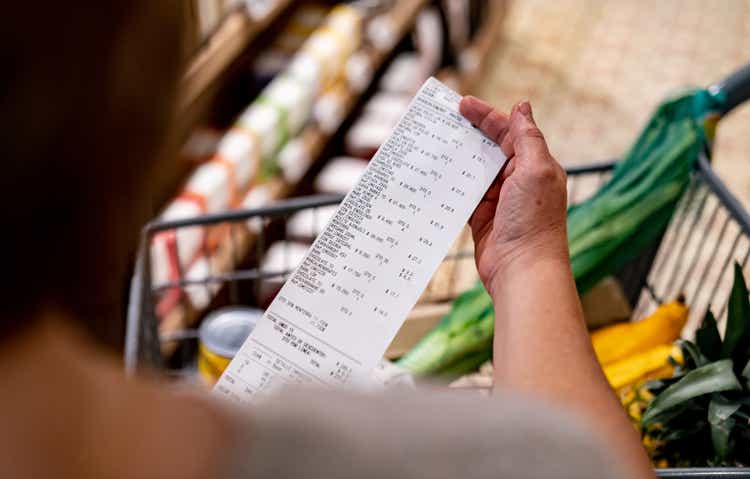andresr
Listen below or on the go on Apple Podcasts and Spotify
The core CPI is forecast to dip to 3.7%, with headline CPI steady at 3.1%. (0:20) DoJ reportedly investigating Alaska Airlines door blowout. (2:54) BofA sees gold rising, but at a slower rate. (4:46)
The following is an abridged transcript
The top story to look out for this week
The markets will get the latest retail inflation figures before the bell on Tuesday, the last numbers before the March 20 Fed meeting.
Economists expect that the February CPI rose 0.4% on the month, with the annual inflation rate staying steady at 3.1%. The core CPI, which excludes volatile food and energy prices, if forecast to have risen 0.3%, with the yearly rate falling to 3.7% from 3.9%.
In a recent survey, 60% of J.P. Morgan clients said that they believe the release is more likely to surprise to the upside than the downside.
Rates have been trending lower despite signs that disinflation was ebbing. Since the January core PCE price index showed inflation heating up, rising 0.4% on the month, the 10-year Treasury yields (US10Y) is down about 10 basis points to 4.08%.
Currently the market is pricing in a near certainty that the Fed keeps rates unchanged at the next meeting. The first rate cut is expected in June.
Michael Darda, chief economist and strategist at Roth MKM, says: “Many on the FOMC look at the 1998 rate cuts during the Asian Crisis as a contributor to the 1999-2000 ‘equity bubble’ and do not want to repeat that experience. Similarly, Fed Chair Powell has cited 1966-1967 (the one time the Fed moved quickly enough to prevent recession after a curve inversion) as a mistake. That is, after a sharp slowdown,”
“After a dramatic two-year inflation overshoot, the FOMC would probably rather risk being late and/or insufficient with cuts/easing than doing too much too soon and having to put out another inflationary fire. This means recession risk is likely much higher than the increasingly bullish consensus would have us believe.”
Looking to earnings, Oracle (ORCL) reports on Monday. In previewing the numbers, SA analyst Jonathan Weber says “we can expect Oracle’s cloud business, which includes both the Infrastructure as a Service business and the Software as a Service business, to be responsible for a major portion of the company’s overall revenue growth. The cloud business grew by 25% during the second quarter, reported in December, and a roughly similar growth rate would not be very surprising for the following quarter.” Weber is Neutral on the stock.
On Tuesday, On Holding (ONON) and Kohl’s (KSS) weigh in.
Wednesday brings Petco (WOOF), Lennar (LEN) and Dollar Tree (DLTR).
For Dollar Tree, same-store sales are expected to be up 2.7% during the quarter, with a 5.4% gain for Dollar Tree stores making up for a 0.7% decline for the Family Dollar chain. There were some indications that momentum picked up at the end of the quarter for the Dollar Tree banner.
Earnings on Thursday include Dollar General (DG), Adobe (ADBE) and Blink Charging (BLNK). Jabil (JBL) reports on Friday.
Among the top stories of the weekend
The U.S. Department of Justice has launched an investigation into an Alaska Airlines (ALK) emergency in which a piece of aircraft fuselage from a Boeing 737 MAX blew out mid-air early this year. That’s according to The Wall Street Journal.
Federal investigators have already contacted some passengers and crew on the flight from Ontario, California, to Portland International Airport on Jan. 5.
The Seattle Times late on Friday reported that Boeing (BA) leadership in a letter to U.S. Senator Maria Cantwell had said that they could not find any records for work done on the blown door plug of the Alaska Airlines flight.
The SEC approved new requirements this week for public companies to disclose their greenhouse gas emissions, but without a key provision that was opposed by business groups.
The new rule, finalized in a 3-2 vote, would require companies to report on their Scope 1 and Scope 2 emissions, which come from sources a company owns directly and indirectly from the source of energy it purchases and uses. The original proposal included requirements to report Scope 3 emissions, which encompasses emissions produced up and down the supply chain; companies were deeply opposed to this requirement, saying it would be too expensive, complex and burdensome.
And a looming reduction in bitcoin’s (BTC-USD) supply growth, known as the halving event, is poised to boost the price of the highest-profile cryptocurrency to more than $115,000 in 2024. That’s according to a recent study by crypto tax-reporting firm CoinLedger.
A year after the past two halvings – there have only been three so far – the price of bitcoin surged by an average of 400%. CoinLedger based its $115,000 price prediction on whether the token is at $69,000 when it halves in April.
A bitcoin halving occurs when the reward for miners like Marathon Digital (MARA and Riot Platforms (RIOT) is slashed in half, essentially reducing the rate at which new tokens are created by 50%. That means the halving – which occurs about every four years – reduces the supply of new bitcoins entering the market.
And in the Wall Street Research Corner
BofA’s technical teams says gold (XAUUSD:CUR) will rise in 2024, but its price movement will slow due to stretched relative strength index conditions.
Analyst Paul Ciana says: “The recent five-day rally surpassing a 5% gain was a bit of a surprise despite being in-line with our medium-term outlook (of lower yields, lower USD, and higher gold).” He added the rally seemed early.
Gold is now the most overbought since March 8, 2022, when it peaked at $2,052 and then declined from $2,050 to $1,650. It is now up more than 19% from a year ago and up nearly 5% year-to-date.




